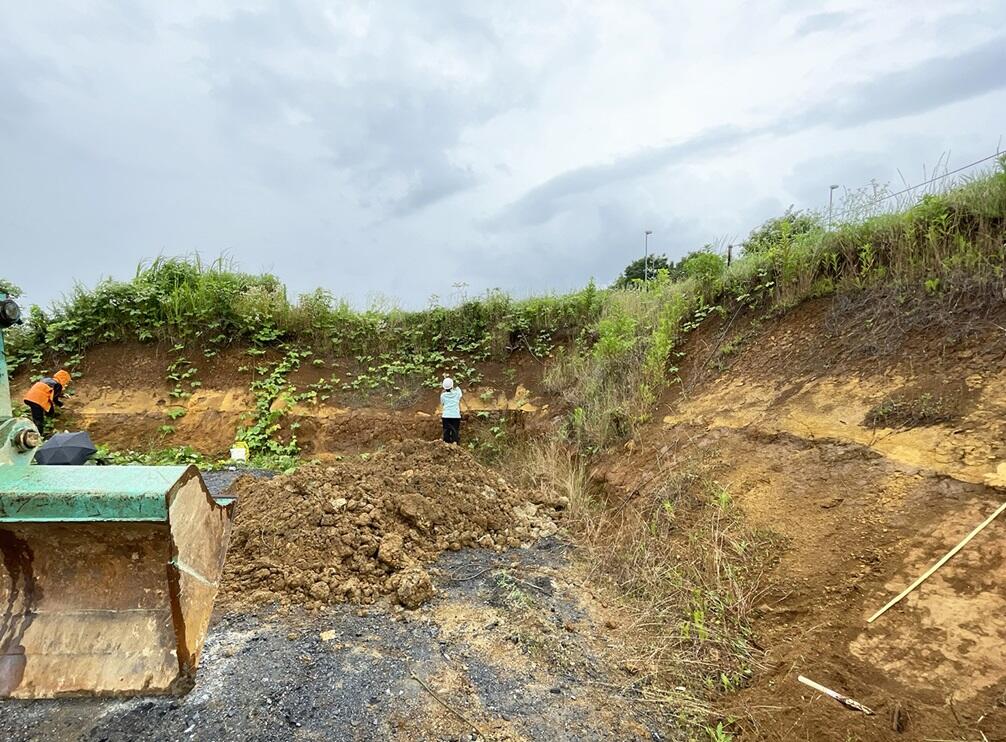Bulletin of the Geological Survey of Japan Top Page
Bulletin of the Geological Survey of Japan Vol.76 No.3 (2025)
Cover photograph | Table of Contents | Abstract
Cover photograph
New terrace outcrop near the Tomobe Junction, Kasama City, Ibaraki Prefecture
Mito district in Ibaraki Prefecture contains fluvial and marine terraces that formed after the middle Pleistocene. Recently, new terrace outcrops have been created as a result of road construction, exposing Quaternary volcanic ash layers, including the Akagi–Kanuma Pumice (Ag-KP, ~44 ka). This photograph shows an outcrop located southeast of the Tomobe Junction, where the Joban and Kita-Kanto expressways intersect (Loc. 1 of Sato, 2025 in this issue). The light-colored yellow-brown layer is the Ag-KP, which is divided into two units based on grain size and the refractive index values of heavy minerals. A second tephra layer, located ~70 cm above the Ag-KP, is probably the Aira–Tanzawa tephra (AT, 29–30 ka). For details, see Sato (2025) in this issue.
(Photograph and Caption by SATO Yoshiki)Table of Contents
All the pages PDF : 76_03_full.pdf [21MB]
| Title | Author | |
|---|---|---|
| Article | ||
| Tephrostratigraphy of the Pliocene Ikego Formation on the northern Miura Peninsula and correlation with widespread tephra beds in central Japan | UTSUNOMIYA Masayuki, MIZUNO Kiyohide and TAMURA Itoko (p.133-147) | 76_03_01.pdf [4.1MB] |
| Report | ||
| Preliminary report on volcanic ash layers in the northeastern part of the Higashi-Ibaraki Terrace, Mito District, northeastern Kanto Plain, eastern Japan | SATO Yoshiki (p.149-162) | 76_03_02.pdf [8MB] |
Abstract
Tephrostratigraphy of the Pliocene Ikego Formation on the northern Miura Peninsula and correlation with widespread tephra beds in central Japan
UTSUNOMIYA Masayuki, MIZUNO Kiyohide and TAMURA Itoko
The Ikego Formation is one of the upper Pliocene stratotype sections of the northwestern Pacific region, owing to the abundant tephra beds in the formation and a robust chronological framework based on biostratigraphy and magnetostratigraphy. This study aimed to correlate tephra beds in the Ikego Formation with widespread tephra beds in other basins in central Japan, based on microscopic observations, heavy mineral compositions, and refractive index measurements and elemental analyses of glass shards from 10 vitric fine ash tephra beds (IkT03, IkT16, IkT19, IkT28, IkT34, IkT37, IkT41,IkT45, IkT63, and IkT75). As a result, IkT45 is correlated with Msg-Iwm of the Kobiwako and Tokai groups, and IkT75 is correlated with Hbt1-MT2, which is widely recognized in other Pliocene basins in central Japan.
Preliminary report on volcanic ash layers in the northeastern part of the Higashi-Ibaraki Terrace, Mito District, northeastern Kanto Plain, eastern Japan
SATO Yoshiki
Loam (i.e., tephric loess deposits), terrace deposits, and three volcanic ash layers occur in three outcrops in the northeastern part of the Higashi-Ibaraki Terrace in Mito district, northeastern Kanto Plain. Analysis of the sedimentary facies, mineral compositions, and refractive index values of volcanic glass shards and heavy minerals suggest that the Akagi–Kanuma Pumice (Ag-KP) occurs at all three sites, in addition to tephra layers that are older and younger than the Ag-KP. The older layer occurs in the Ibaraki Formation and is presumed to be the Akagi–Mizunuma 6 tephra (Ag-MzP6), based on refractive index values and surrounding geology. The younger layer is most likely the Aira–Tanzawa tephra (AT). The Ag-KP deposit around the study area is charactered by a basal unit of fine-grained ash containing orthopyroxene with a lower refractive index than that of orthopyroxene in the rest of the deposit. Previous studies have reported similar basal units in areas to the ESE and SE of Akagi volcano. This distribution of the basal unit is generally consistent with that of the thicker part of the Ag-KP. The spatial distribution of refractive index values indicates that a precursory eruption might have occurred before the main eruption. This hypothesis should be evaluated by further studies, especially geochemical analyses that provide insight into magma mixing during the eruption event.
Geological Survey of Japan, AIST
- About GSJ
- Our Activities
- Purchase guide
-
Publications and Database
- information
- Bulletin of the Geological Survey of Japan
- bull2025(Vol.76)
- bull2024(Vol.75)
- bull2023(Vol.74)
- bull2022(Vol.73)
- bull2021(Vol.72)
- bull2020(Vol.71)
- bull2019(Vol.70)
- bull2018(Vol.69)
- bull2017(Vol.68)
- bull2016(Vol.67)
- bull2015(Vol.66)
- bull2014(Vol.65)
- bull2013(Vol.64)
- bull2012(Vol.63)
- bull2011(Vol.62)
- bull2010(Vol.61)
- bull2009(Vol.60)
- bull2008(Vol.59)
- bull2007(Vol.58)
- bull2006(Vol.57)
- bull2005(Vol.56)
- bull2004(Vol.55)
- bull2003(Vol.54)
- bull2002(Vol.53)
- bull2001(Vol.52)
- Bulletin of the Geological Survey of Japan(old)
- Annual Report on Active Fault and Paleoearthquake Researches
- Reports, Geological Survey of Japan
- CCOP-GSJ Groundwater Project Report
- CCOP Technical Bulletin
- Cruise Report
- Geological Hazards
- Learning and Education
- GSJ Database Collection
- Collection of links


